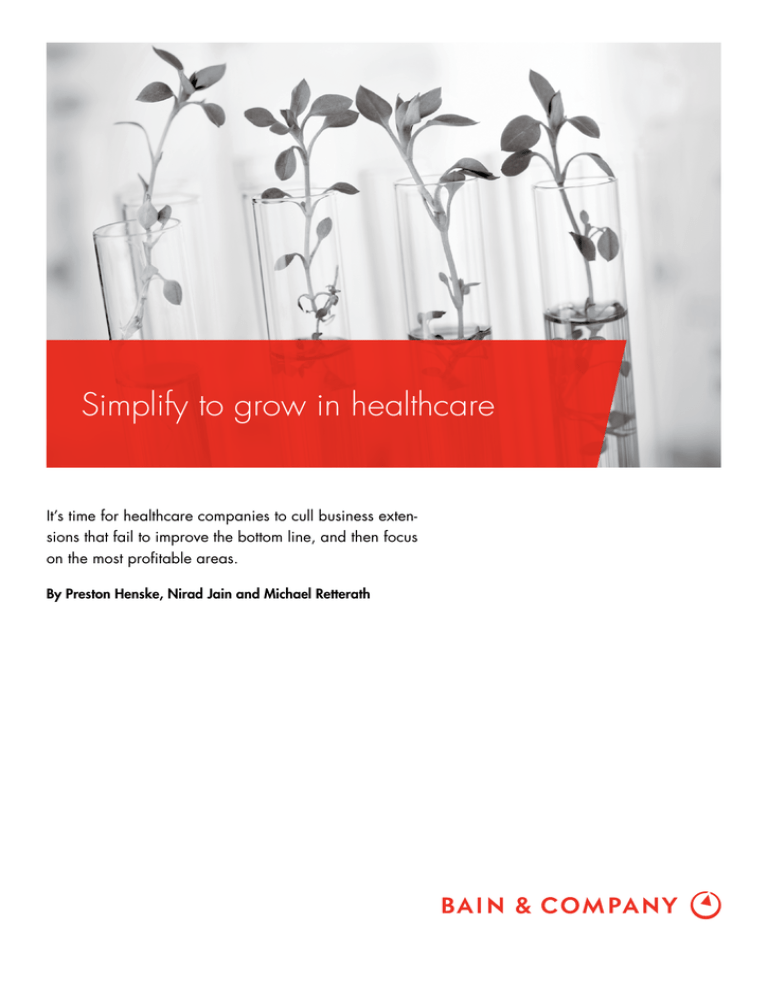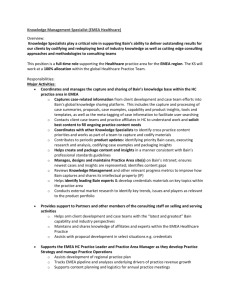Simplify to grow in healthcare
advertisement

Simplify to grow in healthcare It’s time for healthcare companies to cull business extensions that fail to improve the bottom line, and then focus on the most profitable areas. By Preston Henske, Nirad Jain and Michael Retterath Preston Henske, Nirad Jain and Michael Retterath are partners in Bain & Company’s Healthcare practice, and they are based in New York. Copyright © 2015 Bain & Company, Inc. All rights reserved. Simplify to grow in healthcare The call to simplify may sound obvious, but it runs counter to the growth strategies of most pharmaceuticals and medical technology companies. Many have pursued revenue growth through expansion and investment in more countries, additional product variations and new customer segments. As a result, their businesses have become rife with complexity, which has raised costs, slowed innovation time to market and impeded decision making across the entire organization, usually without delivering profitable growth. In fact, much of the investment made to grow actually creates a drag on the core business. With all our investment in new products, new customers and new countries, why don’t we see profitable growth for the company overall? And exactly where in the company do we find the strongest profitable growth? When a global medical diagnostics firm reached the point at which it could no longer answer these two fundamental questions, it decided to undertake a deep analysis of economic profitability by region, customer segment, product and other dimensions, featuring a rigorous total cost allocation along each dimension. The findings shocked executives. It turned out that secondary countries significantly lagged on profitability. For instance, just 1.5 percentage points of profit growth in the largest country market was equivalent to the total profit of the entire Venezuela operation. Even in a country such as India, after years of investment, a path to profitable growth proved elusive. How did healthcare firms wind up in this morass? There are several explanations. Market creep has largely involved building infrastructure and making product investments to tap into the fastgrowing economies of emerging markets. Yet too often, the limited market sizes and challenging local regulatory and competitive situations have tempered any benefits and added significant complexity, not just to the new markets but also to core markets, since many corporate functions serve both types of markets. As a result of these subscale pockets of the business, some organizations have grown to two or three times the size they need to be to support the core. This bloat has the effect of distracting management from higher priorities, slowing decisions and obscuring accountability. The call to simplify may sound obvious, but it runs counter to the growth strategies of most pharmaceuticals and medical technology firms. One top-five global medical technology firm, for instance, found that a particular business unit had a long tail of unproductive regions and product SKUs (see Figure 1). The company was unintentionally shunning core customers and curbing profitability in pursuit of revenue growth. By shifting the focus back to core growth opportunities, the company dramatically increased profitability while also streamlining the business, narrowing its direct markets from 35 to fewer than 10 and its product platforms from 14 to 5, and cutting in half the number of SKUs. The research and development (R&D) pipeline could focus on a much smaller set of programs benefiting the core business. The executive team decided they would exit or serve indirectly the unprofitable and low-profit countries. They would narrow the focus to 12 key regions where the firm could directly improve commercial effectiveness and focus innovation and supply chain capabilities on growth in those regions. Just four months after the analysis, growth in the largest country market began to run well ahead of expectations because of the increased attention and resources. Similarly, at a top five pharmaceuticals firm, the head of global manufacturing recently told us that products making up 5% of total revenue caused 60% of manufacturing overhead. More broadly, many healthcare supply chain executives complain vehemently that the business units don’t realize the supply chain complexity and cost they generate through their commercial decisions. Organization creep often stems from adding new capabilities or from a series of acquisitions, many of which turn out to be subscale or tangential to the core business. 1 Simplify to grow in healthcare Figure 1: Sales volume and profit are often concentrated in a small number of product SKUs and country markets Product volume by SKU Operating profit contribution by market 100% 100% 80 80 50 SKUs represent 90% of volume 60 40 Top 10 markets account for 95% of operating profit 60 40 20 20 0 0 10 30 50 70 90 150 200 250 100% 100% Market 1 Market 35 Rank order SKU Percentage 47% of total 90% 98% 100% Source: Bain & Company One large pharmaceutical company had added capabilities and functions to respond to providers and payers playing more prominent roles in decision making. New functions included health outcomes research, key account managers, institutional selling groups, customer marketing and beefed-up scientific liaison groups—each with its own management structure, meetings and boards. The resulting organizational complexity became untenable. The company decided to start with a clean sheet, redesigning its operating model with the minimum required size and scope. Some pharmaceutical and medical technology companies have come to understand that simplification does more than just reduce costs; it also makes decision making easier and faster and helps functions such as R&D and supply chain to more effectively direct their resources. Once a firm identifies its profitable core products and markets, it can concentrate on attaining leadership in those few categories. The emerging leaders in this regard are actively managing complexity by following a few best practices described below. Find out where the money is—today and tomorrow Pipeline creep derives from the scientific basis of the healthcare industry, which encourages companies to pursue interesting products or markets adjacent to their core products. Too often, pipelines have been filled with projects that make incremental improvements rather than major innovations or with single-market products that add complexity and lack the potential for large-scale adoption. Executives find it hard to know what really matters in the pipeline and how to make the right trade-offs. Many large healthcare firms have little visibility into the profitability of individual products, customer segments or countries, given the division-within-parent structure and accounting processes oriented around functions and regions. Cost allocation methodologies overburden certain regions and only allocate direct costs to products, resulting in incomplete and misleading profitability data. Growth strategies for emerging markets tend to be broad, 2 Simplify to grow in healthcare vague and focused more on future revenue than on profit growth. As attention and resources get diverted to hot new opportunities, the sales and service approach for primary markets typically becomes stagnant, lacking rigorous customer segmentation, tailored execution and feedback loops. showed was two to five times the standard costs. Presented with that new hurdle, only a few of the new SKU requests made business sense. So the quest for simplicity may well start by doing a profit cube analysis to determine the true profitability of a business across several dimensions. The profit cube allocates costs to each combination of dimensions based on an analysis of each driver of cost. Managers can view profitability at a detailed level (such as by customer or product) and at a higher level (such as by region) to inform their decisions about improving overall profitability through different levels of pricing or service. Once the profit cube has identified where value is actually created in the business, a company can rationalize and focus its efforts on those areas, such as prioritizing R&D resources to places that will lead to profitable growth. It’s essential to figure out what will be sustainably profitable. If the demand opportunity in, say, Venezuela, suggests that investing there will generate meaningful profit growth over time, then it’s worth the investment. If not, a company can export to Venezuela from a core market, so long as the exported supply does not add undue complexity to the core operation, or it can choose to exit that market (see Figure 2). Steer resources to core areas, pare back the others At one medical device business, for example, individual country heads would ask for new product permutations to meet their own market needs, because there seemed to be a business case for them. But the standard cost basis used for new SKUs didn’t adequately reflect the full supply chain complexity cost, which profit cube analysis At the diagnostics firm, a profit cube analysis determined that its largest country market creates half its total profit, with most of that concentrated in two product lines and Figure 2: Deciding whether and how to serve each market Sustainably profitable standalone? No Yes Favorable path to profitability? Yes Core profit contributor? Yes No Potential core profit contributor? No Yes No Commercial partner exists; is it as profitable as serving directly? No Captive Serve directly or via active distributor Commercial partner exists; costs can be removed feasibly? Yes Yes Export Serve via distributor or licensing agreement Source: Bain & Company 3 No Exit Start to wind down Simplify to grow in healthcare two customer segments. That analysis informed the path forward, including tactics to retain the core customer segments that were already buying and to attract similar customers that were not. As for other segments, the firm would serve them but not actively seek them out, because the selling costs were prohibitive. Outside the core region, the firm narrowed its markets to 11 others that it would serve directly. level. Some complexity may need to be added back to address important business needs, but the bar for such additions should be high. Adjust incentives and processes to reinforce simplicity Complexity always wants to creep back into an organization, unless it’s actively managed and resisted. Such management works through two critical avenues: compensation and processes. As a result of these decisions, the firm could cut much of its long tail of unproductive SKUs. In the core market, since two product lines and two customer segments accounted for most of the profits, the selling organization and the R&D group now could clearly see where to focus their resources. Compensation generally should focus more narrowly on specific objectives aligned with the drivers of profitable growth. Incentives could be tied to some combination of metrics that a C-suite would track—for instance, revenue growth, profit growth, relative market share, Net Promoter Scoressm tracking customer advocacy, percentage of sales from new products and changes in cost of goods sold. A tailored combination of metrics will help a company attain a higher value, improve its strategic position, build the essential capabilities and enhance the culture. Take a clean-sheet approach to improve decision making A program to reduce complexity must be cross-functional. The most insidious complexity usually occurs not within a function but rather along the seams where different groups interact. Without a cross-functional approach, eliminating complexity in one element of the business will cause it to surface elsewhere. Some processes, in turn, should be designed to prevent complexity from creeping back in. A company can, for example, charge a true complexity-based cost to its regions for developing a new SKU, capability or function. When the true cost of complexity is calculated, many proposed additions will fail to yield an acceptable return on investment. For example, many pharmaceutical companies have cut costs by downsizing the army of sales representatives, pooling resources into shared services and reducing redundancies from businesses that overlap in the wake of mergers and acquisitions. But the cost trimming has not necessarily reduced the number of organizational nodes where decisions and priorities get set, so complexity remains at the seams between functions, business units or regions. ••• Managing a more focused business allows executives to steer resources to the areas that create the greatest value. Streamlining enables faster and better decision making, because there are fewer nodes that could delay the process or obscure the strategic priorities. And having a clearer view of the core strategic sweet spots guides executives in designing the capabilities and organization they need to win. Thoughtful simplification, in short, helps sprawling healthcare companies return to sustained profitable growth. An effective tool in this regard is a clean-sheet operating model designed for a minimum level of complexity and a limited number of organizational nodes. A key part of the design involves ensuring that resource allocation decisions get made at the right level; for instance, commercial resource trade-offs for different products should be made at a regional level, not an individual country Net Promoter Scoresm is a trademark of Bain & Company, Inc., Fred Reichheld and Satmetrix Systems, Inc. 4 Shared Ambition, True Results Bain & Company is the management consulting firm that the world’s business leaders come to when they want results. Bain advises clients on strategy, operations, technology, organization, private equity and mergers and acquisitions. We develop practical, customized insights that clients act on and transfer skills that make change stick. Founded in 1973, Bain has 51 offices in 33 countries, and our deep expertise and client roster cross every industry and economic sector. Our clients have outperformed the stock market 4 to 1. What sets us apart We believe a consulting firm should be more than an adviser. So we put ourselves in our clients’ shoes, selling outcomes, not projects. We align our incentives with our clients’ by linking our fees to their results and collaborate to unlock the full potential of their business. Our Results Delivery® process builds our clients’ capabilities, and our True North values mean we do the right thing for our clients, people and communities—always. Key contacts in Bain & Company’s Global Healthcare practice Americas: Preston Henske in New York (preston.henske@bain.com) Nirad Jain in New York (nirad.jain@bain.com) Michael Retterath in New York (michael.retterath@bain.com) Asia-Pacific: Karan Singh in New Delhi (karan.singh@bain.com) Europe, the Middle East and Africa: David Michels in Zurich (david.michels@bain.com) For more information, visit www.bain.com








